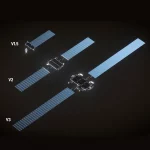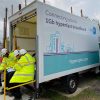Three UK Study – 5G to do 100Mbps Broadband, Replace Fixed Lines
Ovum has today published a new report, commissioned by mobile operator Three UK, which claims future 5G technology will deliver home broadband speeds of 80-100Mbps. Furthermore they predict that it could “replace traditional connections” for 85% of the UK’s 26 million fixed line ISP customers, with “equal or better speeds.”
The report is interesting for a number of reasons, not least because it examines the viability of 5G based Fixed Wireless Access (FWA) services (used to connect individual homes and businesses) and makes a number of big claims that are worth examining in more details.
Most FWA services offer a targeted and faster type of wireless broadband delivery, which is designed to compete with fixed line connections. Such services typically use frequency bands that are similar to WiFi and often require end-users to install special antennas on the outside of their properties (not always necessary in urban areas, but often essential in rural areas where signals must travel further and can be weaker).
Advertisement
By comparison Mobile operators usually adopt a different setup and model for reaching users in the highly variable mobile environment (Smartphones etc.). Overall Ovum’s study makes five key claims about the potential benefits of a 5G based FWA service vs fixed lines.
5G FWA vs Fixed Lines (Ovum)
• 5G-FWA’s mmWave performance is comparable to or better than existing fiber-based products.
This makes it a plausible substitute to wired broadband. 5G-FWA is as fast or faster than existing fiber-based products. Ovum has witnessed speeds of 1–3Gbps in live commercial trials with limited customer numbers. We expect large-scale deployment to be able to consistently support speeds of 80-100Mbps, which is better than many existing fiber-based connections.
• 5G-FWA can serve 85% of the existing UK fixed-line market.
Currently, the average actual speed delivered to UK households stands at 46.2Mbps, but there is a substantial proportion of households receiving much lower speeds, both in urban and sparsely populated areas of the country. The percentage of urban customers receiving speeds below 80Mbps is approximately 85%. Fiber (FTTC) customers across the UK receive an average download speed of 46.2Mbps, which is half the speed 5G wireless broadband can expect to deliver.
• 5G-FWA can address customer pain points.
It can save families an estimated £240 per year, as fixed-line rental is not required. Moreover, customers do not have to go on a fiber “waiting list” dependent on their postcode. Having to wait for engineer appointments, be present during installation, and drill holes through walls to pass cables are pain points that a plug-and-play wireless solution can eliminate.
• The ecosystem for 5G-FWA is developed from the outset.
There have been plenty of attempts in the past to use wireless as a substitute for wired broadband connectivity (e.g. WiMAX). These attempts have failed because of the lack of support from both the telecom operator community and the technology vendor community. But 5G wireless broadband is already benefitting from deployments by large-scale telecom operators and equipment manufacturers. Moreover, it uses the same technology as 5G mobile, which is fully standardized and endorsed by all telecom operators in the world.
• Deploying 5G-FWA can be almost 50% cheaper than laying fiber.
Economic modeling indicates that implementing 5G-FWA is much cheaper than using fiber. Such a calculation is important for mobile-only operators with no existing fiber footprint. The cost of deployment can be much lower mainly because of the civil engineering cost (e.g. digging roads) associated with fiber deployment.
On the first point it’s worth remembering that many existing FWA broadband ISPs can already deliver speeds of up to around 100Mbps and some existing 4G networks (e.g. EE) will similarly offer such speeds to ordinary mobile users during certain times of the day (e.g. dense urban areas when fewer people are hogging the traffic), it’s all a matter of how you setup and feed the network.
The vague comparison with “fiber-based” networks is also somewhat unhelpful as this could be covering a multitude of sins, not least since slower FTTC (VDSL2) networks are very different from the latest multi-Gigabit capable Fibre-to-the-Premises (FTTP) connections. We dare say that Virgin Media would also have something to say about 80-100Mbps being better than their cable network.
On the second point the figure of 46.2Mbps being used is not solely for FTTC connections and is instead an average of different fixed line connections combined, which stems from Ofcom’s 2018 study of fixed broadband ISP speeds (here). But it is questionable of Ovum to be comparing speedtest based data with a rough prediction of 5G network performance.
Advertisement
On the third point Ovum talks about saving £240 per year, not least by “eliminating the need for fixed-line rental” (phone). But this is debatable and depends upon how much the service itself will cost and whether consumers then go out to buy a replacement VoIP service. Likewise it’s unclear whether they’re considering the cost of matching fixed lines by offering unlimited usage allowances and avoiding CGNAT etc.
However, what Ovum seems to be getting at is that mobile operators, like Three UK, have an advantage over existing FWA and fixed line networks in that they should be able to quickly roll-out ultrafast 5G services to cover the vast majority of the country, in a fairly short space of time. This is as opposed to the current approach where FWA ISPs tend to only serve niche areas and many fixed line services can still be quite variable / slow.
Meanwhile their final point about 5G-FWA being 50% cheaper than “laying fiber” (we assume they mean FTTP) does overlook the fact that you still need fibre optic cables to deliver all that capacity for the base stations and masts in the first place (although Microwave links can help). Likewise once you’ve deployed FTTP then switching it from 1Gbps to 10Gbps to 20Gbps to 100Gbps etc. becomes a lot easier in the future and those speeds are reliable (capacity / hardware allowing).
Dave Dyson, CEO of Three UK, said:
“5G gives consumers the opportunity to bin their fixed line, enjoy faster speeds and save money. Wireless home broadband means that we can speed up access to super-fast internet services at a lower cost, without installation delays or inflexible contracts.
The efficient and widespread rollout of superfast broadband across households and businesses is crucial to the growth of our economy. Wireless home broadband de-risks Government’s ambitions for a Digital Britain by providing alternatives to a fibre-to-the-home solution.
At Three, we’re making significant investments to make this technology viable as we ready our network for 5G. Government and Ofcom have the right ambition to improve UK connectivity and we will work with them to show that there are other alternatives to fibre.”
At present the argument being made above is a bit chicken and the egg because we first need to see what consumers will get before being able to judge how it compares. On the other hand 5G does certainly have the potential to shake-up the fixed line market and the slow pace of FTTP builds will give it space to grow, even despite a late start.
Advertisement
The first commercial 5G services from EE and Three UK should tentatively start to roll-out next year, but they won’t fully kick off until more spectrum is released in 2020 and it will then need c.7 years to reach coverage maturity. By then FTTP is also predicted to have become available to over half of UK premises.
Meanwhile Three UK has made no secret of their desire to take the 144MHz of 5G friendly spectrum that they have and use it to deliver both FWA and Mobile connectivity services across the UK (here). But they’ll need to grab even more spectrum frequency if they intend to deliver on what’s proposed above (keep a close eye on Ofcom’s future auctions).
Likewise all that spectrum will need to be fed with enough capacity, which is comparatively easy to do in urban areas but in a few years’ time FTTP providers will have tackled many of those too. One of the big question marks will thus be over whether the sorts of speeds being talked about above can also be delivered to the final 40% of premises, outside of the most lucrative urban markets.
Dario Talmesio, Principal Analyst and Practice Leader at Ovum, said:
“Advantages of 5G wireless broadband technology are not just in speed: wireless is more flexible, does not require long-term contracts, is faster and cheaper to deploy and less of a burden for customers – no waiting time, no engineer visits.
With low availability of fibre and high cost of deployment, 5G Wireless becomes a viable alternative to fixed-line broadband. While the UK continues its fibre roll-out, this is a quicker and more economical way to satisfy customers’ fast-growing demand for data.”
Finally, Ovum’s report hints that 5G-FWA services will also adopt a “plug-and-play” setup (i.e. no engineer visits) and offer more flexible contracts (i.e. no longer terms, but this is a choice for each operator and not technology specific), which sounds a lot like the 4G based Relish Wireless ISP that Three UK owns. But that provider hasn’t exactly been a speed demon. They’ll need to do much better with the 5G version.
UPDATE 21st Nov 2018
A new demo has been conducted in London, which showed how Three UK and Huawei’s kit could hit speeds of up to around 3-4Gbps under ideal conditions (here).
Mark is a professional technology writer, IT consultant and computer engineer from Dorset (England), he also founded ISPreview in 1999 and enjoys analysing the latest telecoms and broadband developments. Find me on X (Twitter), Mastodon, Facebook, BlueSky, Threads.net and Linkedin.
« Rural FTTH Project from the UK Wins 2018 EU Broadband Award


















































Comments are closed